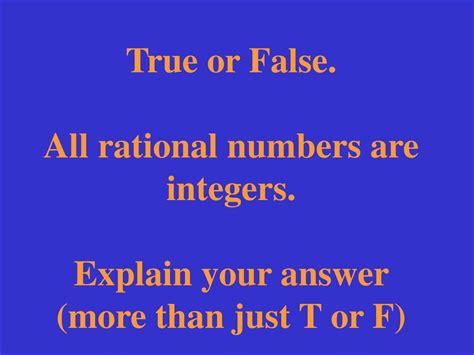All Integers Are Rational Numbers True Or False
News Leon
Apr 01, 2025 · 4 min read

Table of Contents
Are All Integers Rational Numbers? A Deep Dive into Number Systems
The statement "All integers are rational numbers" is true. Understanding why requires a clear grasp of what constitutes integers and rational numbers. This article will explore these number systems in detail, providing a rigorous proof of the statement and addressing common misconceptions. We'll also examine related concepts and delve into practical applications of this fundamental mathematical principle.
Understanding Integers
Integers encompass the set of whole numbers, including zero, their positive counterparts, and their negative counterparts. This can be represented as:
{... -3, -2, -1, 0, 1, 2, 3 ...}
Integers are often used to represent quantities that are discrete and countable, such as the number of apples in a basket or the number of students in a classroom. They form the basis for many mathematical operations and are crucial in various fields like computer science, finance, and physics.
Key Characteristics of Integers:
- Whole Numbers: Integers are whole numbers; they don't include fractions or decimals.
- Negatives: Integers include both positive and negative numbers, representing values above and below zero.
- Closure Under Addition and Subtraction: Adding or subtracting two integers always results in another integer.
- Additive Inverses: Every integer has an additive inverse (its negative), such that their sum equals zero.
Understanding Rational Numbers
Rational numbers, denoted by the symbol Q, are numbers that can be expressed as a fraction p/q, where 'p' and 'q' are integers, and 'q' is not equal to zero. This definition is crucial in understanding their relationship to integers.
Examples of rational numbers include:
- 1/2: One-half
- 3/4: Three-quarters
- -2/5: Negative two-fifths
- 5/1: Five (any integer can be expressed as a fraction with a denominator of 1)
- 0/1: Zero
Key Characteristics of Rational Numbers:
- Fractional Representation: The defining characteristic is their expressibility as a fraction of two integers.
- Decimals: Rational numbers can be represented as terminating or repeating decimals. For instance, 1/2 = 0.5 (terminating), and 1/3 = 0.333... (repeating).
- Density: Between any two distinct rational numbers, there exists another rational number. This implies that rational numbers are densely packed on the number line.
- Closure Under Addition, Subtraction, Multiplication, and Division (excluding division by zero): Performing these operations on two rational numbers always results in another rational number.
Proving that All Integers are Rational Numbers
The proof is straightforward, relying on the definition of rational numbers. Every integer 'n' can be written as the fraction n/1. Since 'n' and '1' are both integers, and the denominator '1' is not zero, the integer 'n' satisfies the definition of a rational number.
Therefore, all integers are rational numbers.
Formal Proof:
Let 'n' be any integer. Then we can write 'n' as n/1. Since 'n' is an integer and '1' is an integer, and 1 ≠ 0, 'n' satisfies the definition of a rational number. Therefore, 'n' is a rational number. This holds true for all integers. Hence, the statement "All integers are rational numbers" is proven.
The Relationship Between Integers and Rational Numbers: A Venn Diagram
The relationship between integers and rational numbers can be easily visualized using a Venn diagram. The set of integers is a subset of the set of rational numbers. This means that all integers are contained within the larger set of rational numbers, but not all rational numbers are integers.
Imagine a circle representing integers and a larger circle encompassing the integers, representing rational numbers. The smaller circle (integers) is entirely within the larger circle (rational numbers).
Common Misconceptions
Some common misconceptions arise when dealing with these number systems:
- Confusing Rational and Irrational: Irrational numbers, such as π (pi) and √2 (the square root of 2), cannot be expressed as a fraction of two integers. They have non-repeating, non-terminating decimal representations. This is a key distinction from rational numbers.
- Assuming All Fractions are Rational: All fractions with integers in the numerator and denominator (excluding zero in the denominator) are rational.
- Thinking Integers are a Separate System: Integers are a crucial part of the broader rational number system. They are a foundational subset.
Real-World Applications
The understanding that all integers are rational numbers has significant implications in various fields:
- Computer Science: Representing numbers in computer systems often involves using rational number representations, especially when dealing with calculations involving integers.
- Finance: Calculations involving monetary amounts frequently use rational numbers, as these often involve fractions of a currency unit.
- Physics: Many physical quantities can be represented using rational numbers, enabling precise measurements and calculations.
- Engineering: Engineering designs and calculations often utilize rational numbers for representing dimensions and ratios.
Conclusion
The assertion that all integers are rational numbers is demonstrably true. This understanding hinges on a thorough grasp of the definitions of both integers and rational numbers. The relationship between these number systems is fundamental to mathematics and its various applications, underpinning countless calculations and models across diverse fields. The ability to confidently differentiate between integers, rational, and irrational numbers is key to advanced mathematical understanding and problem-solving. By solidifying this understanding, you can build a stronger foundation for further exploration into the fascinating world of numbers and their properties.
Latest Posts
Latest Posts
-
What Is The Oxidation Number Of Sulfur In Na2s2o3
Apr 02, 2025
-
Select The Correct Statement About Osmosis
Apr 02, 2025
-
Does Reactivity Increase Down A Group
Apr 02, 2025
-
How Many Vertices Does Octagon Have
Apr 02, 2025
-
Reaction Of Ammonia And Sulfuric Acid
Apr 02, 2025
Related Post
Thank you for visiting our website which covers about All Integers Are Rational Numbers True Or False . We hope the information provided has been useful to you. Feel free to contact us if you have any questions or need further assistance. See you next time and don't miss to bookmark.
